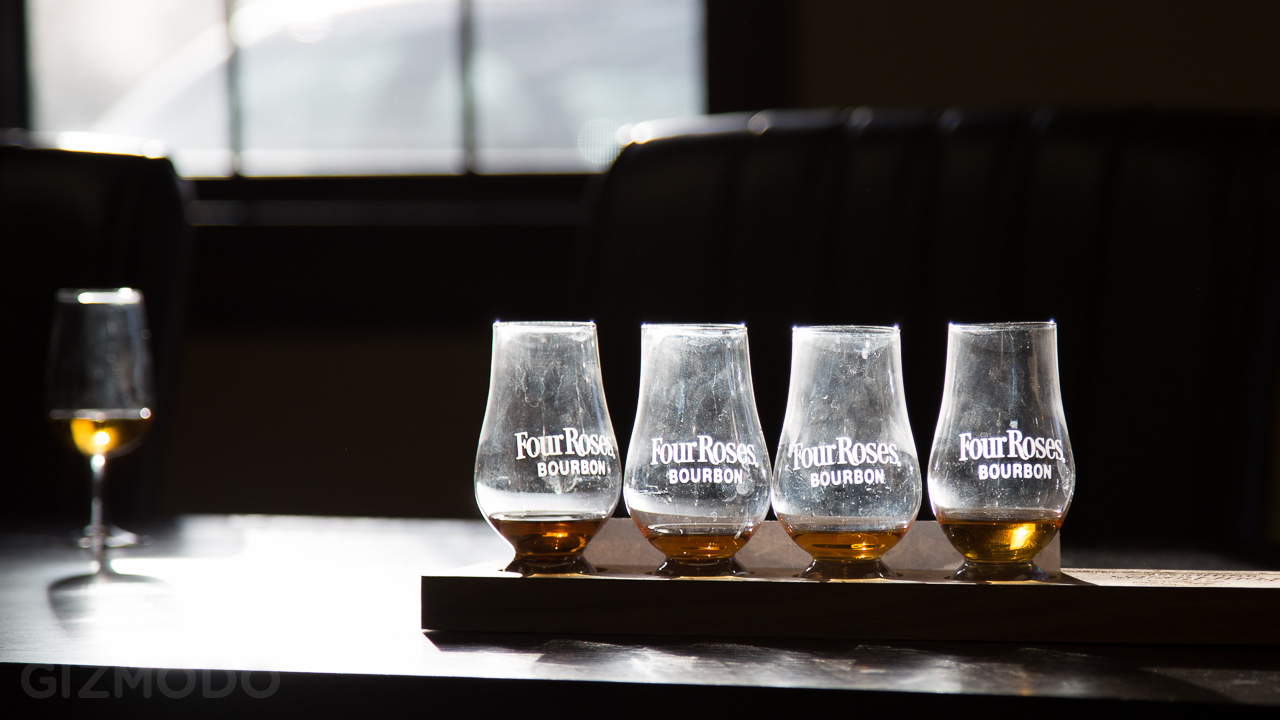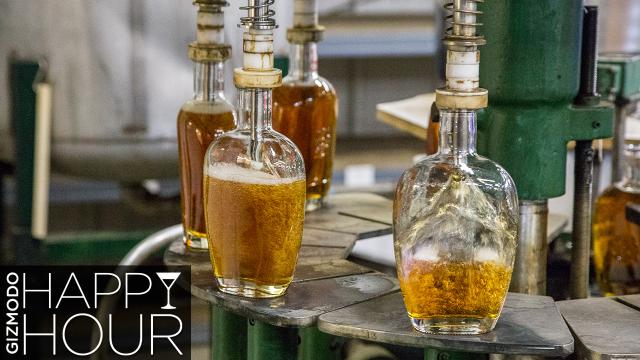If there’s one thing the Gizmodo crew agrees on, it’s bourbon. Sweet liquid gold. It’s pretty much the classic American spirit, and it’s experiencing a massive boom at the moment. Whiskey producers are going to great lengths to keep up with demands. So we thought it was high time we took a look at how this delicate and beautiful creature is made. (Play the sexy music.)
It’s time for Happy Hour, Gizmodo’s weekend booze column. A cocktail shaker full of innovation, science and alcohol.
There are many dozen full-sized distilleries pumping out bourbon, and micro-distilleries are popping up left and right. There are a handful of rules that dictate what can be called bourbon (which we’ll get to in a moment), but within that there is a lot of room for distillers to play, which is why there’s such a huge range of flavour (and quality) within the bourbon family.
We were recently invited by Four Roses to come see their operation in the US state of Kentucky, and we decided to take them up on it (because we lovedistilleries). Four Roses is interesting because it distills 10 different recipes, and then blends them into different products using different ratios (and in a bid to maintain consistency). We’ll outline the differences and commonalities as we go.
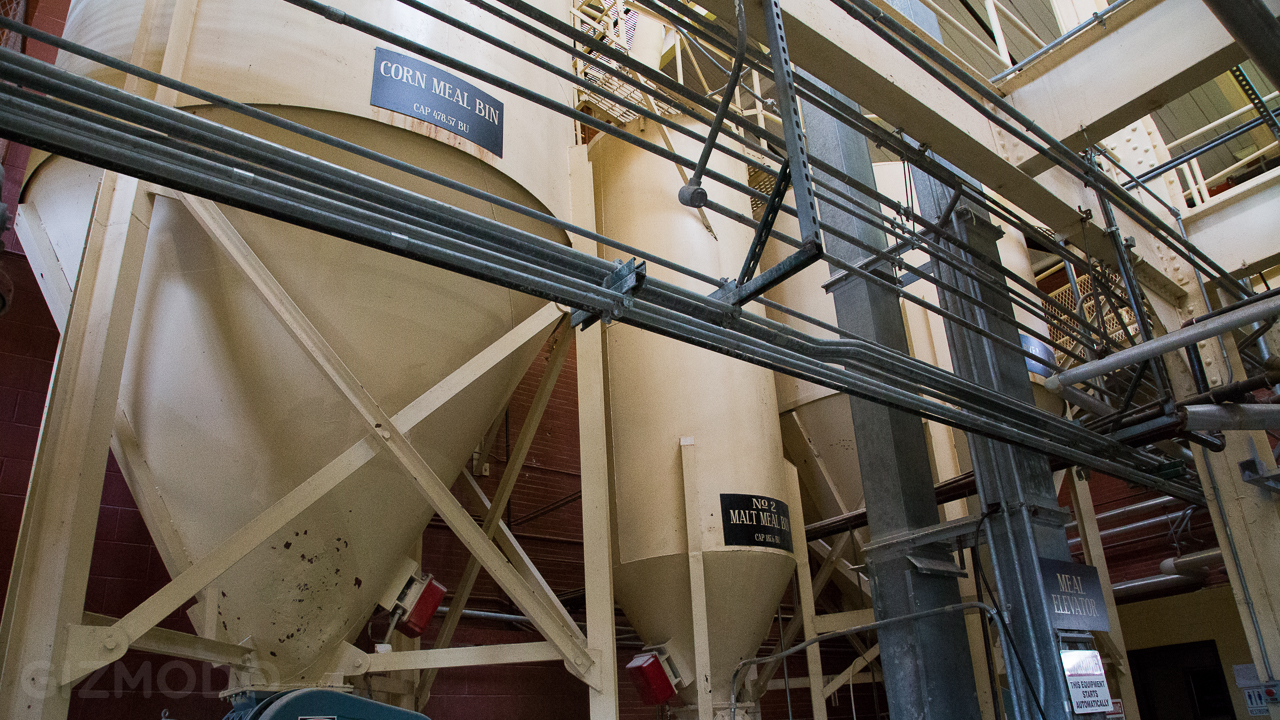
Mash Bill and Beer
All bourbon starts with a mash bill, that is, a distillery’s chosen ratio of grains. In order for a whiskey to be bourbon, the mash bill must be at least 51 per cent corn. Them’s the rules. The rest of it is typically rye and malted barley. Some mash bills contain wheat, in which case you have what’s known as a “wheated bourbon”, which tends to be a bit sweeter.
Four Roses has two mash bills that it uses. “E-Mashbill” is 75 per cent corn, 20 per cent rye, and 5 per cent malted barely. The “B-Mashbill” is 60 per cent corn, 35 per cent rye, and 5 per cent malted barley. The rye-heavier B-Mashbill has a spicier, full bodied flavour.
The grains are purchased dried and are carefully quality-controlled. Since a lot of distilleries share a common grain source, they kind of have each others’ backs. If one spots a little mould or must in their grain, they’ll alert the others. Mouldy and musty flavours will go all the way through the distilling and ageing process and can ruin a whole batch very easily. The approved grains all pass through a large hammer mill where they’re turned to a gritty flour.
From there, the processed grains are transferred into the “beer well”, and the cooking begins. The corn is typically added first and cooked for the longest at the highest temperature (around 220 F). It’s then allowed to cool down a bit, and the rye and, finally, the barely are mixed in. This is what is known as a “mash.” Large pumps circulate it while it’s cooking to ensure it’s cooked evenly. The whole cooking process typically takes less than an hour, because overcooked grains begin releasing undesirable flavours, and it’s really just the sugars they’re after. This stage of the process smells mouth-wateringly good, like hot cereal and beer and everything that’s right with the world.
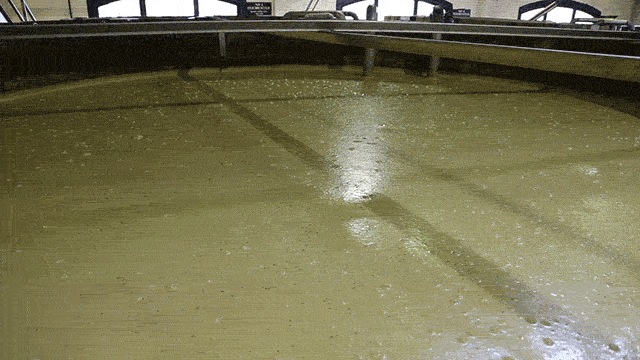
Yeast and Fermentation
Once the mash has cooled, it is piped over to a large fermenter. This is where the alcoholic magic begins.
Not all yeast is created equal. Yeasts are little microorganisms that mutate extremely quickly, and there are thousands of different types out there. Yeasts feed off of the sugars in the mash and produce alcohol and carbon dioxide as byproducts. Surprisingly, though, different yeasts yield very different flavours. Distilleries jealously guard their proprietary yeasts because it’s such an essential part of their product’s flavour.
Here again, Four Roses does something different. Back when they were owned by Seagram, the food scientists there did exhausted research on different yeast strains and their resulting flavours. They ended up with five favourite proprietary yeasts all of which are still used today. So we’ve got five different yeasts being used in two different mash bills, hence the 10 different recipes.
The yeast strains are carefully cultivated. When it’s time to make a new run of bourbon, a small amount of the yeast they want is added small amount (typically a cup or two) of a sterile yeast mash (a sweet solution that yeast thrive in). Once the yeast has had a chance to propagate, those two cups of liquid are added to a large bucket of liquid, and more propagation takes place. That is how they get a sufficient quantity of yeast for the inoculation of the large fermenters. Once it’s ready, it’s tossed into the mash awaiting in the fermenters.
As the yeast does its thing, the solution begins to bubble so much it’s almost simmering. At the same time, the whole room has a wonderful smell, like sourdough bread just starting to bake. The vats are kept warm until the solution reaches roughly 10 per cent alcohol by volume (ABV). Then it’s time to concentrate the stuff.
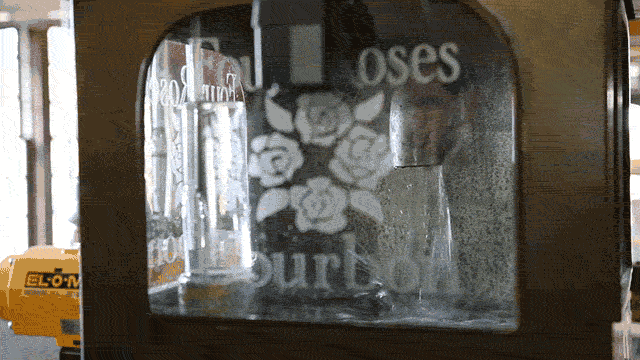
Distillation
10 per cent ABV would be plenty strong if we were making beer, but bourbon must be bottled at 40 per cent or more, so we’ve got some work to do. Traditionally, back in ye olde drunke dayes, bourbon was made in a large pot still, but today the majority of large distilleries have swapped them out for column stills (also known as continuous stills).
The column still is essentially a large vertical tube that is cut into partitions by metal plates. Each of these sections acts as a small pot still, working in series. The plates at the bottom of the column are very hot, making almost all of the liquids evaporate, but as the column goes higher and higher, the plates get cooler and cooler. This causes the water to condense and fall back down, while the alcohol (which boils at a much lower temperature) remains vapour and continues rising to the next level.
At the end of the distillation you are left with “low wine” (pictured above) which is a clear spirit ranging between 45 and 65 ABV (or 90-130 proof). We tasted some of it, and there still some serious funk on it at this point in the process. That’s why it’s distilled once again, this time in a smaller still known as a doubler. When it it comes out of the doubler it’s typically only about 5 per cent higher in ABV, but it really takes the nasty edge off. What you’ve got is a very strong, but less harsh spirit called “high wine,” but you know it as The Barrels
One of the requirements for bourbon to be bourbon is that it must be aged in new, charred, white-oak barrels. Distilleries don’t generally make their own barrels, but purchase them pre-built and pre-charred from a third party. Four Roses (and many others) goes through a company called Independent Stave. There can actually be a lot of variation within these barrels, though. For example, different barrels may have a different number of staves in them, which would affect the oxidation levels, ever so slightly. You can also request a light char or a heavy char, where the barrels are burned for longer. The barrels are super critical to the flavour of the bourbon. In fact, according to Jim Rutledge, Four Roses Master Distiller, about 95 per cent of the sweetness you can taste in bourbon comes from the wood-sugars in the barrel. The primary reason the barrels are charred is because this caramelises those sugars and brings them closer to the surface. (You can see a video of the whole process here.) Most distilleries use 55 gallon barrels. When the spirit is poured into the barrels it cannot exceed 125 proof (62.5 per cent ABV). That’s just another one of those bourbon rules. So water may be added at that point to bring the proof down, if necessary. The the bung (plug) is hammered into the bung-hole (yep, that’s where that comes from), and the ageing begins. The barrels are then rolled into a warehouse where they will age. Four Roses has 20 warehouses, each of which are one acre in size. They can each hold 24,000 barrels. That’s a maximum capacity of 480,000 barrels, or 26,400,000 gallons of ageing whiskey. That’s more than three times the volume of the killer-whale tanks at Sea World. Fascinatingly, between each warehouse is a large trough: just in case one of the warehouses catches fire, the troughs will direct the river of burning whiskey away from the other warehouses. Uniquely, Four Roses is the only large distillery that houses their ageing barrels in single story warehouses. They do this to minimise temperature variation, which has a significant impact in the resulting whiskey. Even though Four Roses warehouses are just six barrels high and the difference in temperature between the top and bottom is only six degrees, the two barrels on the bottom will lose proof during the ageing process, the two barrels at the top will gain proof, and the two two in the middle will stay about the same. So why doesn’t everybody keep their whiskey in underground warehouses where the temperatures are always the same? It’s because some variation in temperature is actually a good and necessary thing. As the temperatures rise and fall, the wood expands and contracts, sucking in the whiskey and pushing it back out. It’s this ebb and flow that allows the spirit to pull the deeper sugars out of the wood. There’s a misconception that ageing is always better. In actuality, the sugars dissipate first, and once they’re gone the whiskey will get more and more tannic, and those bitter wood characteristics start coming out. “Once the sugars are gone, you’ve got about six months to use it,” according to Rutledge. “The trick of the business is picking the barrels when they’re at their peak of performance.” Determining this peak of performance, however, is more art than science. You could have two barrels of whiskey that are identical in every perceivable way, and yet one will reach maturity at six years, while the other will peak at eight. Some seem to be magic and just keep getting better well into their teens, but this is rare. To determine when they’re ready, they typically start tasting the barrels around five years. They drill a couple small holes, let a little out, and then hammer a couple wood spikes back into to plug the holes (removing the bung every time would be too messy and labour intensive, requiring them to remove the barrels from their racks). Once the barrel is determined to be at its peak, it’s removed from the warehouse and is usually dumped into a large trough that runs into a tank, where it will be stored with other bourbons of its type (remember, Four Roses uses 10 recipes) and/or age until it’s ready to be used. Four Roses has three varieties in the States. The 80 proof “Yellow Label” is a blend of all 10 of their recipes. This gives them a lot of variables for tweaking to they can get a very consistent flavour. There’s also the 90 proof Small Batch, which uses four of the recipes, and is richer and smoother. Lastly there’s the 100 proof Single Barrel, which uses only one of their recipes (the same one every time), and has a somewhat more distinctive flavour. For the blends, there isn’t a certain ratio they follow (23 per cent recipe A, 14 per cent recipe B, etc). Sure they start there, but then they start tasting as they go. They’re looking for a particular flavour profile, and they will keep adding stuff and tweaking the ratios until they’ve hit it. Once they’ve got it dialled in, then it’s bottle time. The stuff we drink domestically is all bottled on site at the facility in Cox’s Creek, KY. It’s a mix of automated machinery and manual labour. For instance, there are a couple people who put the corks onto every bottle, but then there’s a machine that tamps it down all the way. There’s a machine that fills the bottles to the perfect measure, but there’s a dude who loads the bottles into boxes. For Europe and Asia, however, the finished whiskey is pumped into a tanker and then shipped off overseas where it will be bottled in the U.K. or in Japan (where Four Roses is a massive brand — in fact, it’s owned by Kirin). This makes perfect sense, since everything that has to do with the flavouring is done, but shipping boxes of bottles just wastes space and product. Japan actually gets two blends we don’t: Black Label and Super Premium. This is a shame because of all the Four Roses types I sampled these two were by far my favourite. They were almost introduced here, too, but American focus groups didn’t like them. Ugh. Is there nothing focus groups can’t ruin? If you want to try one of them you’ll have to get a travelling friend to sneak one back for you. It’ll be worth it. So that’s where all that tantalising, golden bourbon you love so much comes from. Sometimes seeing how things are made robs them of their mystery and makes them less appealing. With bourbon, somehow, it just makes you appreciate it even more. Have a nice, slow-sippin’ weekend, and see you next week for another Happy Hour. Thanks to everyone at Four Roses for the tour and their time.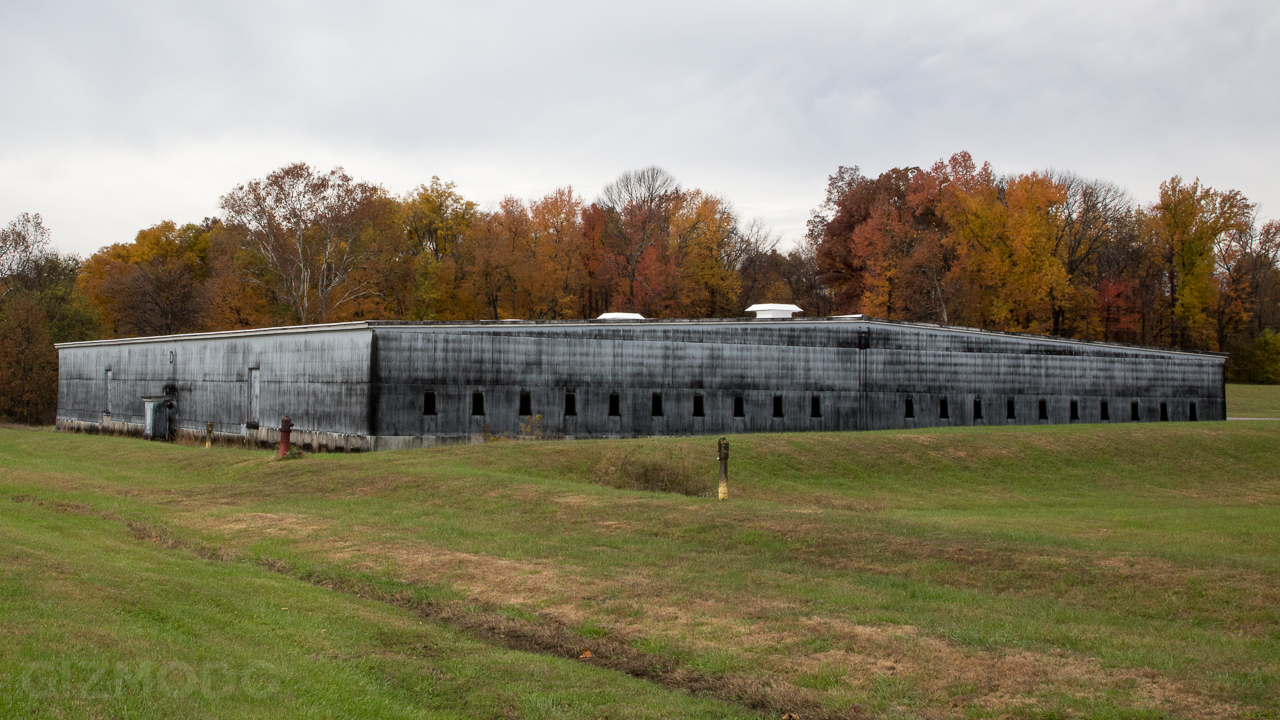
Ageing and Testing

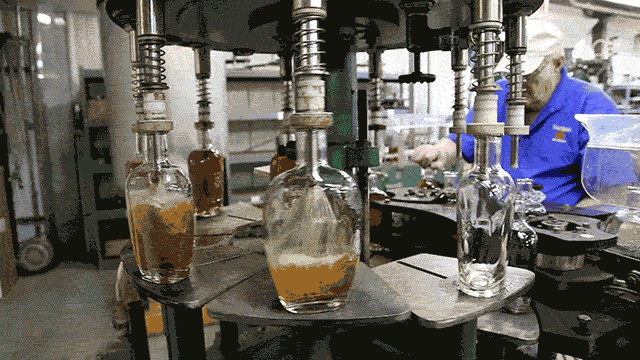
Blending and Bottling
